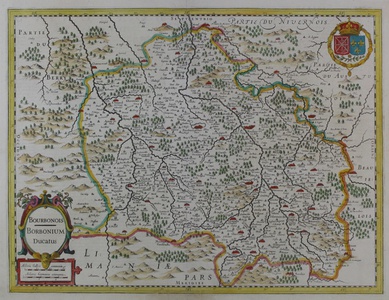| Method | Copper engraved with hand colour |
| Artist | Mercator, Gerard and Hondius, Jodocus |
| Published | [Amsterdam, c.1619] |
| Dimensions | 375 x 500 mm |
| Notes |
A map of the historic Borbonnais region of central France, from a Latin edition of the Mercator-Hondius Atlas. The map centres on the principal Bourbon city of Moulins, picked out in red, along with a number of other important regional cities and towns. Mountains, rivers, and forests are shown pictorially, and the boundaries of the region and its neighbours are outlined in hand colour. The map is further embellished by a large Royal coat of Arms for the Kingdoms of France and Navarre under Henry IV, the first French monarch of the House of Bourbon, as well as a strapwork title cartouche with a scale in German and Gallic miles. Gerard Mercator (1512 - 1594) originally a student of philosophy was one of the most renowned cosmographers and geographers of the 16th century, as well as an accomplished scientific instrument maker. He is most famous for introducing 'Mercators Projection', a system which allowed navigators to plot the same constant compass bearing on a flat map. His first maps were published in 1537 (Palestine), and 1538 (a map of the world), although his main occupation at this time was globe-making. He later moved to Duisburg, in Germany, where he produced his outstanding wall maps of Europe and of Britain. In 1569 he published his masterpiece, the twenty-one-sheet map of the world, constructed on Mercator's 'Projection'. His 'Atlas, sive Cosmographicae Meditationes de Fabrica Mundi', was completed by his son Rumold and published in 1595. After Rumold's death in 1599, the plates for the atlas were published by Gerard Jr. Following his death in 1604, the printing stock was bought at auction by Jodocus Hondius, and re-issued well into the seventeenth century. Jodocus Hondius (14th October 1563 - 12th February 1612) was a Dutch Flemish cartographer, engraver, and publisher. Hondius is most famous for reviving the primacy of the work of Gerard Mercator, through the publication of his Atlas, and the smaller Atlas Minor, in the early seventeenth century, at a time when cartography was largely dominated by Ortelius' 'Theatrum Orbis Terrarum'. The Mercator-Hondius Atlas was composed of maps pulled from plates Hondius had purchased from Mercator's grandson, as well as thirty-six new plates Hondius commissioned, and in many cases engraved, himself. He is also believed to have been the chief engraver of the plates for John Speed's 'Theatre of the Empire of Great Britaine'. Following his death, he was succeeded by his sons, Jodocus the Younger and Henricus, as well as his son in law Jan Jansson. Condition: Central vertical fold, as issued. Repaired splits to central fold. Printers crease to left of central fold. Latin text on verso. |
| Framing | unmounted |
| Price | £300.00 |
| Stock ID | 46776 |

